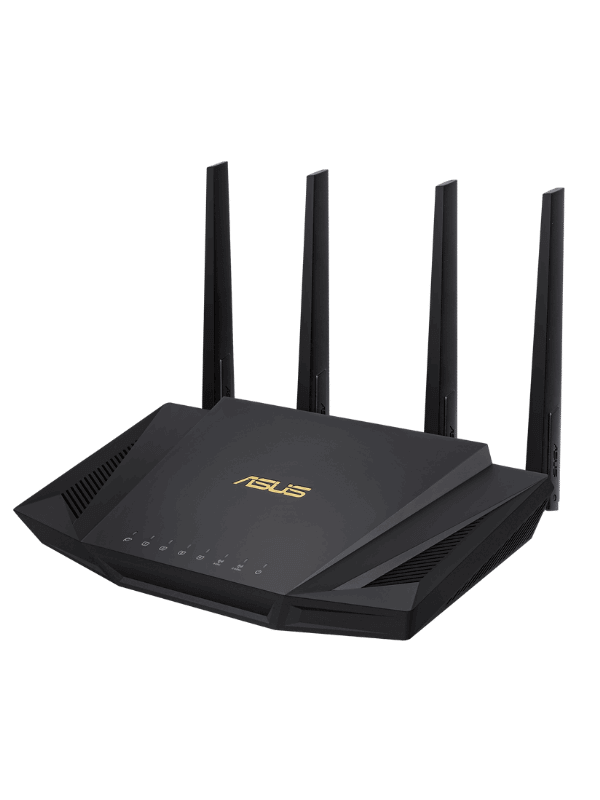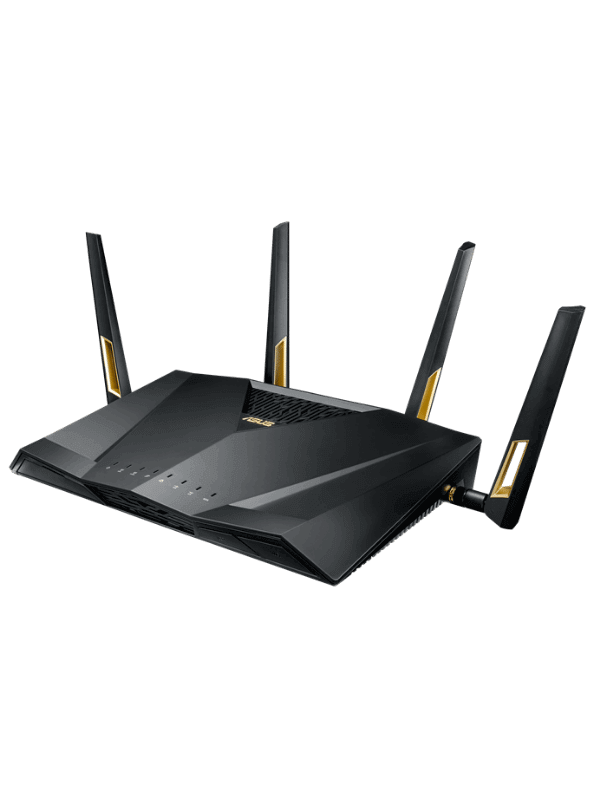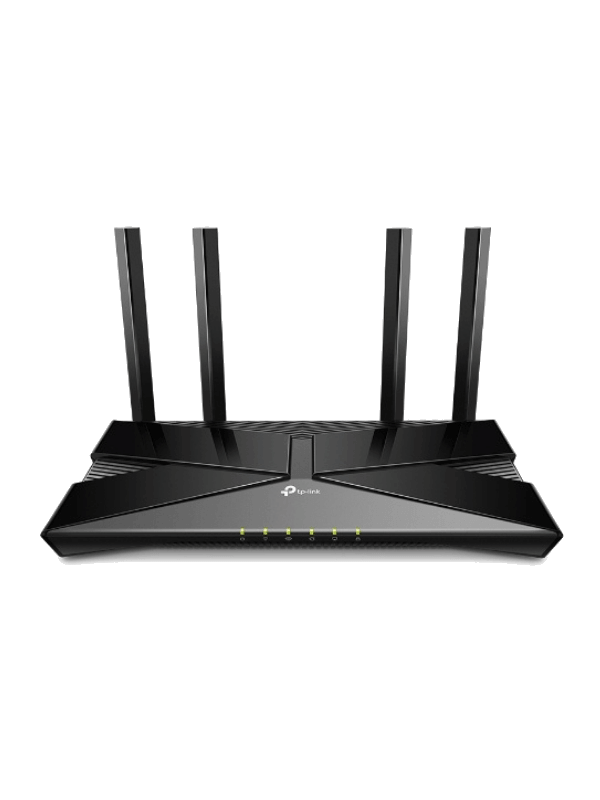Welcome to our review of the ASUS RT-AX3000, also known as RT-AX58U.
We will refer to the router as RT-AX3000 in this article since that is the “global” designation. But everything here should also apply to the RT-AX58U model. Which, as far as anyone can tell, is the exact same device.
We got the RT-AX3000 a couple of months ago, and have personally run speed and reliability tests in order to give a real-world opinion.
In addition, we bought the router ourselves, so we won’t hold back or hide any of its flaws.
The ASUS RT-AX3000 is a compact but potent mid-range router that delivers excellent performance. Not to mention, it comes in at an incredible price.
Its small size might have you think that the RT-AX3000 is lacking power or features. But that couldn’t be further from the truth.
Let’s take a deeper look into this great device so you can decide if it meets your needs.
ASUS RT-AX3000 Overview
![ASUS RT-AX3000 [RT-AX58U] Review 1 RT AX3000 RT AX58U Overview](https://networkshardware.com/wp-content/uploads/2022/02/RT-AX3000-RT-AX58U-Overview.png)
The ASUS RT-AX3000 is a dual-band, Wi-Fi 6 router. It broadcasts in both the 2.4 GHz and 5 GHz bands. As a router, it will need to be paired up with a modem in order to have an Internet connection (not for fiber).
Since it’s compatible with ASUS AiMesh, the RT-AX3000 can also double as either the main router or one of the nodes in a mesh Wi-Fi system. More on that later.
In general, it’s hard to go wrong with the RT-AX3000.
For a mid-range router, and a price that certainly supports that claim, you will be pressed to find a better option.
For starters, this router packs much more features than its competitors (as is usually the case with ASUS).
Things usually reserved for higher-end units, like 160 MHz channels, dual-WAN support, and a mobile app are all present.
On top of that, its performance is borderline premium, being able to output almost gigabit speeds on Wi-Fi.
And that’s just the beginning. Let’s go over the AX3000 spec sheet, discuss some of its most important features, and see if it’s truly a device worth your money.
ASUS RT-AX3000 Specs
| Brand | ASUS |
| Model | RT-AX3000 (RT-AX58U) |
| Max Tested Wi-Fi Speed | 889.41 Mbps |
| Approximate Range | 80-85 feet (~ 25meters) |
| Wireless Standard | Wi-Fi 6 (802.11ax) |
| Bands | 2.4 GHz, 5 GHz |
| WAN Port | x1 |
| LAN Port | x4 |
| USB Port | x1 |
| QoS | Yes |
| Parental Controls | Yes |
| Guest Network | Yes |
| OFDMA | Yes |
| Dimensions | 8.82 x 6.06 x 6.3″ |
| Weight | 538 g |
| Warranty | 2-3 years |
For more info, check out the official datasheet.
Let’s get right into it!
Performance – 4.4
Router manufacturers usually trick you into believing router speeds that are not real. For example, the ASUS RT-AX3000 site claims it can reach 3000 Mbps. [1]
This claimed speed is an aggregation of all of its band’s capacities, and no single device is able to achieve it.
When testing the RT-AX3000 ourselves, we were able to get 889.41 Mbps in the 5 GHz band at 5 feet distance using a Wi-Fi 6 2×2 device.
![ASUS RT-AX3000 [RT-AX58U] Review 2 Tp Link AX50 and the ASUS RT AX3000 side by side](https://networkshardware.com/wp-content/uploads/2022/02/Tp-Link-AX50-and-the-ASUS-RT-AX3000-side-by-side.png)
That might not be what’s advertised on ASUS’s website, but it’s still pretty remarkable. Especially compared to its direct competitors like the TP-Link AX50.
For example, while costing arguably the same, the TP-Link Archer AX50 was about 25% slower during our tests.
The RT-AX3000’s lack of range is the one drawback worth mentioning.
While it still might perform better than competitors at longer ranges, going too far left us without any signal at all. Something that didn’t happen with other routers.
With other mid-range options, even if their performance was severely handicapped, you could at least connect.
This can be solved using mesh Wi-Fi. However, since the RT-AX3000 is a dual-band router, expect the performance of the nodes to be slower than the main router.
This is because satellite nodes use part of the available bandwidth to connect back to the main router.
Features – 4.8
This is where the RT-AX3000 really shines. It is packed with free features that either cost extra, or simply aren’t present in competitors at this price point.
Starting with ASUS’s great web interface, which stands as a favorite amongst enthusiasts. The web portal opens the door to a plethora of features that are sure to cover most, if not all, home networking needs.
Let’s explore some of them.
Wide Channels
The RT-AX3000 supports 160 MHz channels, which means more speed. However, your client devices will need to support them.
Plus, if you live in a crowded area, it might create some interference with other 5 GHz signals. If you want to learn more about channel widths and their benefit, check out this article.
AiMesh
You can use the RT-AX3000 as either the main router or as a satellite for a mesh Wi-Fi system.
It is able to pair up with any other ASUS device that supports AiMesh to create a seamless Wi-Fi network that can cover much larger areas than a stand-alone router.
![ASUS RT-AX3000 [RT-AX58U] Review 4 AiMesh RT AX3000 RT AX58U](https://networkshardware.com/wp-content/uploads/2022/02/AiMesh-RT-AX3000-RT-AX58U.png)
While satellites will perform slightly slower than the main router, we think AiMesh still works very well.
For maximum mesh performance regardless of what device you are connecting to, you will need a dedicated mesh system or tri-band routers.
ASUS App
ASUS’s Router App is a free, alternative way to manage all your router features and configurations.
It lets you do most of what you can do in the web interface, right from your mobile devices.
The best part? No account creation is required, and no hidden in-app purchases.
QoS
A mid-range router with quality of service is not a surprise. But we want to give a special shout-out to ASUS because the RT-AX3000 excels compared to its competitors.
It offers both regular and adaptive QoS, as well as a bandwidth limiter.
![ASUS RT-AX3000 [RT-AX58U] Review 5 QoS RT AX3000 RT AX58U](https://networkshardware.com/wp-content/uploads/2022/02/QoS-RT-AX3000-RT-AX58U.png)
For adaptive QoS, you are able to choose from a wide array of categories depending on your needs. It includes Gaming, Streaming, Web Surfing, File Transfers, and most recently Video Conferencing as prioritization options.
If you are missing any of the options above, a firmware upgrade should make them show up.
ASUS QoS definitely goes the extra mile, and at this price point, it’s hard to beat.
Signal and Performance
The RT-AX3000 offers beamforming, MU-MIMO, and the more advanced OFDMA.
With beamforming, the router will use its antennas to “point” its signal directly to your devices, meaning an improved reception.
With MU-MIMO and OFDMA, the router can leverage each of its individual antennas to connect to multiple devices simultaneously, keeping each stream direct and separate.
There is no need for additional configuration to take advantage of these. However, your client devices need to support them.
AiProtection
Things like AiProtection are what make ASUS stand out.
It comes standard, and free of charge, for life in most ASUS routers. AiProtection offers a very welcome set of additional security features to help you always keep your home network secure.
Within AiProtection you’ll find network protection (supported by Trend Micro), security assessments, malicious site blocking, infected device blocking, and various other features that will keep your security game strong.
Keep in mind that AiProtection is not perfect, or the only security you’ll ever need. But as a free feature, it does an amazing job in covering the basics of network security.
Parental Controls
Parental controls are present in the RT-AX3000 but might be too simple for some of the most concerned parents.
It can only block content from ASUS pre-defined categories like Adult Content, Instant Messaging, and others. This might mean that some unwanted content can slip through the cracks.
![ASUS RT-AX3000 [RT-AX58U] Review 6 Parental Contrls RT AX3000 RT AX58U](https://networkshardware.com/wp-content/uploads/2022/02/Parental-Contrls-RT-AX3000-RT-AX58U.png)
And while there is a time management/schedule option to cut off the Internet from specific devices, there is no specific site or app blocking.
Design – 3.9
The first thing you’ll notice about the RT-AX3000 is how small it is.
Looking at pictures online you might think it’s an intimidating device. But the truth is it’s even smaller than a “regular” router. It’s very lightweight at 538 grams, and can also be easily mounted to a wall.
![ASUS RT-AX3000 [RT-AX58U] Review 7 RT AX3000 RT AX58U from above](https://networkshardware.com/wp-content/uploads/2022/02/RT-AX3000-RT-AX58U-from-above.png)
Apart from that, it is very “normal” looking. It looks just like you expect a router to look. So, while there isn’t anything bad to say about its looks, it’s nothing to write home about either.
The 4 antennas certainly make a statement, but we didn’t find them to be a problem. And while you can’t remove any of them (not that you should anyway), you can move them around or point them in different directions if needed.
As for ports, it’s as mid-range as they come. Four ethernet gigabit LAN ports and one gigabit WAN port with dual-WAN support. No multi-gig ports are available, though you are unlikely to need them in a home setting.
![ASUS RT-AX3000 [RT-AX58U] Review 8 RT AX3000 RT AX58U backside](https://networkshardware.com/wp-content/uploads/2022/02/RT-AX3000-RT-AX58U-backside.png)
A standard USB 3.0 port is also included, for either storage, printers, or updates.
Setup – 4.6
Setting up the RT-AX3000 as a stand-alone router was simple and quick.
You’ll just need to connect one of your devices to the router, either by using one of the ethernet ports or by connecting to the default ASUS Wi-Fi signal once you turn it on.
Then, access the router’s menu by browsing to its default IP address (192.168.50.1) or by accessing router.asus.com.
![ASUS RT-AX3000 [RT-AX58U] Review 9 Setting up the RT AX3000 RT AX58U](https://networkshardware.com/wp-content/uploads/2022/02/Setting-up-the-RT-AX3000-RT-AX58U.png)
The rest is pretty much standard. If you want to learn more about setting up your router, make sure to check out this guide.
Alternatively, you can download the ASUS mobile app, connect to the default Wi-Fi and set up your whole network right from your phone or tablet.
Value – 4.5
This is another section where the RT-AX3000 stands out. Priced as a mid-range option, it offers features and performance its direct competitors haven’t been able to match.
Sure, you can spend half the cost and still get a good-enough router. Or spend $500 and get a more powerful device.
But if we view it from a price vs. performance perspective, the RT-AX3000 seems to always come out on top of similarly priced options.
It’s important to note that even after mentioning all of the above, value is subjective to each individual situation.
If you only have a 5 Mbps DSL Internet connection, no matter how good this router is, it’s not going to be a good value for you.
You need to make sure your bandwidth can take advantage of its capabilities for it to be worth it.
![ASUS RT-AX3000 [RT-AX58U] Review 10 All routers max speed - Tested by networkshardware.com ASUS RT-AX3000](https://networkshardware.com/wp-content/uploads/2022/06/All-routers-max-speed-Tested-by-networkshardware.com-ASUS-RT-AX3000-783x1024.png)
Reviews of the RT-AX3000
Reviews for the ASUS RT-AX3000 are overwhelmingly positive. A quick Google search will result in hundreds of 8/10 or 4/5 reviews, often even better.
And they are not just from experts or reviewers. Customer reviews seem to indicate consumers are having no problems setting it up or getting the expected performance out of it.
But as you might expect, it’s not perfect.
Most user complaints indicate that its range is not the best in the category or that performance is somewhat degraded when used on mesh Wi-Fi.
We definitely agree with the range claim. It lacks some signal power. For example, the TP-Link AX50, while missing some of the features, has a better range than the ASUS.
As for mesh, by it being a dual-band router we think it’s expected to see reduced performance when connected to satellite nodes.
If you want to avoid this issue, you will need to get a tri-band router and use the third band as a dedicated backhaul. That way, your main 5 GHz band is free and exclusive for your usage.
![ASUS RT-AX3000 [RT-AX58U] Review 11 Tp Link AX50 ASUS RT AX3000 and the ASUS RT AX88U side by side](https://networkshardware.com/wp-content/uploads/2022/02/Tp-Link-AX50-ASUS-RT-AX3000-and-the-ASUS-RT-AX88U-side-by-side.png)
Alternatives
Here are some alternatives to the RT-AX3000.





4 thoughts on “ASUS RT-AX3000 [RT-AX58U] Review”
Been reading a lot of your articles. You’re very knowledgeable. Looking for some expert advice if you have a moment:
ISP: Cox
Plan: Gigablast
Use: Console gaming – Running a small business from home (Data driven – lots of manual & automated website searching/analysis) – Wife also works from home, but her use is way less intense
Gear: Arris Surfboard SGB8300 Gateway
Devices: 8-13 at any given time (Xbox – 2 laptops – 3 smartphones – 2 smart TVs – All-in-1 work station – Printer – FireStik – Alexa Echo – iPad)
Ports: Xbox & PC hardwired
FWIW: 4 devices I gave static IPs – Also opened some ports that EA Sports & Microsoft suggested.
I’ve had this set up for about 2 years now. Running my small business for 1 and only opening ports + stat IP those 4 devices for about 4-5 months. I’ve noticed that for what ever reason I will randomly experience bottlenecking or jittering when gaming. Couple of instances the intermittent lag and packet loss will be enough to lag me all the way out of the game. I’ve tested connection on my pc and Xbox when this happens and they’ll both be around 95-110MB Down. Normally they will be at 700MB+ Down. Which in all honesty 100MB Down should suffice in a clean gaming experience, so that suggested to me that something more is going on. I checked more technical stuff like QAM, DB, upstream levels etc and basically everything for me was showing less than what’s considered normal/baseline. Further reading up on topic led me to a website explaining how the PUMA Chipsets have a history of being problematic, so much so that there was a lawsuit filed and won. My connectivity issues went hand and hand with the problems described on the site and my Gateway has the PUMA 6 Chipsets.
I’d like to purchase a Modem & Router separate and was wondering after reading my novel if you can tell me which models would be good for intended use? I’m not sure what “Busy Network” means in terms of devices connected or data transmissions, but I’d guess that I have a busy network lol But I just don’t want to buy too little, buy too much, or miss out on a quality or feature that would directly benefit my intended usage.
Thanks in advance for any specific advice or opinion! ????????
Hi Rusty,
Thanks for the short novel!
I would recommend the Motorola MB8600 or the Motorola MB8611. The MB8611 has a 2.5 Gigabit Ethernet port and is thus more future-proof. In contrast, the MB8600 is cheaper and enough for plans up to 1 Gigabit (like you have now).
For the router, I would go with either the ASUS RT-AX3000 (the one above) or the ASUS RT-AX88U.
Both of which will be able to take full advantage of your Gigabit plan. The RT-AX88U is faster and has a better range, while the RT-AX3000 is cheaper but still very fast.
You can read more about them in our reviews.
Hope this helps!
My existing Fios router has a coax cable connection, I do not see one on these routers reviewed. What do I do?
Hi Kit,
To help you I will need a lot more information. For example, does your ONT only have coax connections, and do you have Verizon’s Television service?
Depending on your answers, your course of action will be different.
In this article, you can also read the part “How to set up your router with Verizon FiOS.”
It explains the different circumstances you might find yourself in.